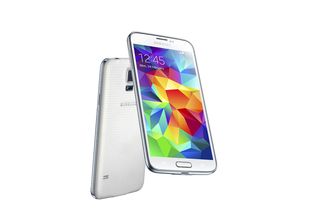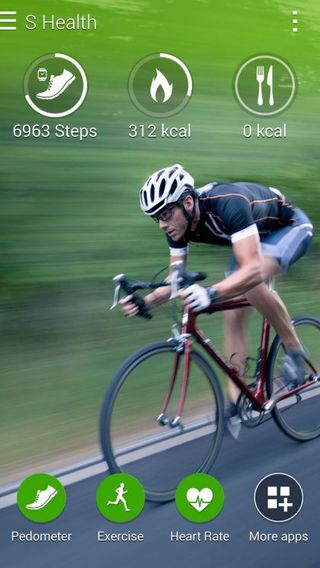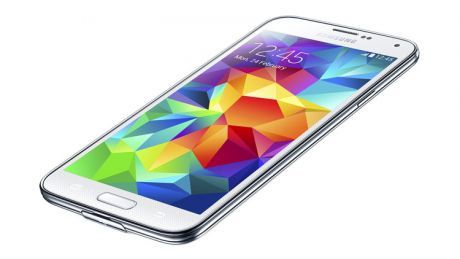You can trust Coach
The Galaxy S5 is Samsung’s most powerful smartphone to date and has more features than anything that precedes it. Improvements have been made across the board to the screen, performance, camera and battery life but Samsung has also turned its attention to fitness, adding exercise-tracking abilities which could give the S5 an edge over competing smartphones.
Getting started
It might be built entirely from plastic, but the S5 still looks sleek thanks to the minimal design, metal effect trim and a dimpled rear cover which creates plenty of grip. It has all the features you would expect from a flagship smartphone, including a fantastic screen: the 130mm, 1080p resolution display uses LED technology to light up each pixel individually. When showing dark or black images, pixels shut off completely, giving the handset unbeatable high contrast. It’s bright, sharp and incredibly colourful – in short it’s the best screen on any smartphone available today.
It’s incredibly quick too. The Qualcomm Snapdragon 801 processor paired with 2GB of RAM makes it the fastest smartphone around – there’s nothing in the Google Play Store the S5 can’t run smoothly. The 16GB of storage isn’t huge, especially if your phone doubles as an MP3 jukebox, but you can add extra capacity with microSD cards.

Despite all that power, battery life is superb. The Galaxy S5 lasts around 17 hours when playing a constantly looping video at half brightness. With NFC, Bluetooth, Wi-Fi and data services switched on we routinely managed over 24 hours on a single charge.
Other highlights include an excellent camera, thanks to a 16-megapixel ISOCELL sensor which takes fantastic photos in bright sunshine using its high dynamic range (HDR) mode. It has an LED flash for low-light shooting and can even mimic the depth of field effects you normally only find in expensive dSLR cameras. Finally, a fingerprint sensor built into the home button lets you unlock the phone with a swipe, rather than tapping in a password; it takes less than a second to recognise your digits, and although not quite flawless it was impressively accurate.
Fitness focus
It’s the new fitness focus, however, that makes the Galaxy stand out above its peers in our eyes. Samsung has added genuinely useful features, including ANT+ connectivity as well as Bluetooth 4.0 and Bluetooth Low Energy that enable it to connect heart rate monitors, cadence sensors and pedometers directly to the handset, rather than indirectly via a fitness tracker or runner’s watch. The entire handset is also IP67 dust- and water-resistant, meaning it won’t give out on you if you get caught in the rain, although you won’t be able to take it swimming.
Like almost every phone the built-in accelerometer can count your steps from within your pocket, but the Galaxy S5 also has a heart rate sensor on the back of the handset for measuring your pulse. We found it slightly inconsistent compared with a dedicated HRM, but it will still give you an idea of how hard you’ve been pushingyourself after a workout.

There's an app for that
All these features feed data into Samsung’s S Health app, which records your daily step totals, exercise sessions, calories consumed and weight. The S Health app isn’t new – Samsung introduced it with the Galaxy S4 – but until now its scope was limited to a small selection of official accessories. Starting with the S5, the company has pledged to open the app up to third-party developers, sharing data from the heart rate sensor and accelerometer so you wouldn’t need to add in details of a run manually or rely on a dedicated fitness tracker. RunKeeper, MapMyRun and Endomondo have all been named as on the list to get support, so there’s a good chance your favourites will be included in the coming months.
S Heath isn’t as detailed as many of the apps designed for dedicated fitness bands we’ve seen, with limited heart rate tracking and no in-depth performance charts to check on your performance. We also found the mapping feature, which plots your run on a satellite map, to be somewhat flaky – it measured a 24km walk correctly, but the map only showed half of our route.
If you prefer to wear something on your wrist rather than keep a phone in your pocket, the Galaxy S5 also works flawlessly with Samsung’s recently-launched Gear 2 and Gear Fit wearables. They have HRMs and pedometers, and feed data directly into the S Health app.
S Health certainly isn’t the final word in terms of fitness, particularly if you’ve already invested in an exercise tracker with more detailed feedback, but it’s still a great addition for anyone just getting started on the road to a healthier lifestyle.

Verdict
The S5 is, hands down, the best Samsung Galaxy smartphone to date. It might not have the same gorgeous all-metal design of HTC’s One (M8) or the Apple iPhone 5s, but it has the best performance, camera and screen of any handset available to buy right now. The fitness features alone make it a winner – even if they’re a little basic it means you’re always able to keep track of your progress, whether you remember to bring a pedometer/HRM or not.
Right now the Galaxy S5 is expensive. The phone has only been out a month and is still in great demand, meaning you’ll have to spend at least £30 a month on a two-year contract, or buy the handset outright for almost £600. However, if you’re out of contract and looking for a new smartphone, the S5 is pretty much the best you can get.
Score: 9/10
RRP: £570 SIM-free
Manufacturer: Samsung
Coach is a health and fitness title. This byline is used for posting sponsored content, book extracts and the like. It is also used as a placeholder for articles published a long time ago when the original author is unclear. You can find out more about this publication and find the contact details of the editorial team on the About Us page.


